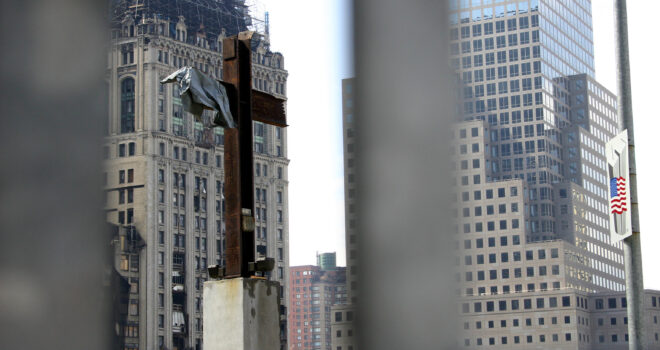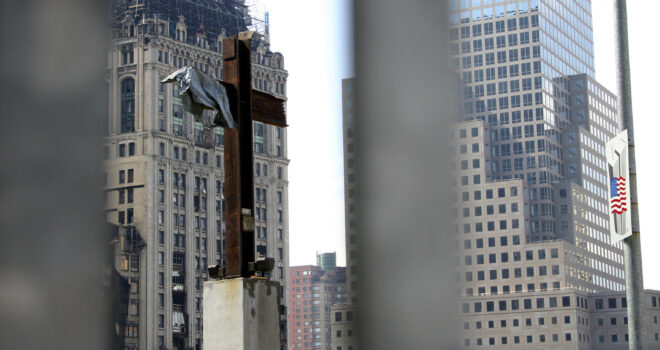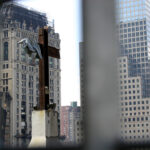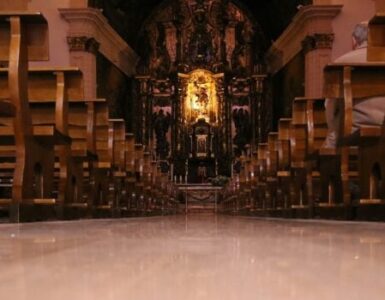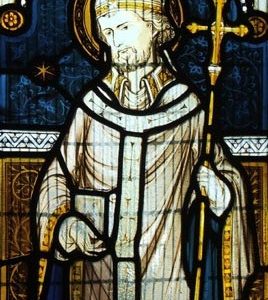Twenty-two years ago on September 14, 2001, the Feast of the Exaltation of the Holy Cross, I walked into one of the darkest moments of my life. At the time, I was oblivious of the spiritual significance of it. I didn’t yet understand how my life will primarily be lived under the shadow of the Cross and that this would in many ways be the beginning of a journey with Our Lord and Our Lady of Sorrows on the Way of the Cross.
It was the day, a Friday that year, when I walked into a room to help hundreds of grieving family members whose loved ones had been murdered three days prior at the Pentagon when terrorists flew American Airlines Flight 77 into the side of the building killing 184 people. I was 20-years-old.
Most of us expect to live ordinary lives. We do not think we will be a part of world history making kinds of days. Days packed with immense spiritual significance in God’s Divine plan. We often forget to see that God is guiding every moment of our lives. He has every single millisecond—and smaller—in the palm of His hand. He is weaving a beautiful tapestry in our lives that we will only understand in the next life.
A profound journey into the heart of the Cross began that afternoon. If memory serves me, I arrived during the 3 o’clock hour: the Hour of Mercy. The first task I was assigned was to hand out roses to grieving families as they walked into the 4:00 pm briefing led by Lieutenant General Van Alstyne—who was in charge of the Pentagon Family Assistance Center where I served as a relief worker.
As Catholics, we know roses are very often a symbol and sign of Our Blessed Mother. It is no accident that my first task on that day when we lift high the Cross, late in the 3 o’clock hour, was to hand roses to those enduring the agony of the murder of their loved ones. An agony Our Blessed Mother knows more than any other human being created by God. What I didn’t understand until years later, is that a year prior to this moment, the Lord began laying the groundwork for leading me to understand that my place in this life is with Our Lady of Sorrows at the foot of the Cross enduring the silence of the Cross with others.
I enlisted in the U.S. Navy in September of 1999 on the Memorial St. Vincent de Paul. I ended up stationed at the Defense Language Institute after bootcamp and spent 15 months living in Monterey, California. On a bright, beautiful September afternoon—there seem to be a lot of those in my life—I was making a day trip with friends from Monterey to Big Sur down spectacular coastal Highway 1. We had just passed through Carmel when I spotted a beautiful monastery on the left hand side of the road situated across from the Pacific Ocean. It was at the base of Mount Carmel in California. It was in a picturesque location near where the mountain meets the sea. A “thin place” as Celtic saints would have called it.
God’s plans are so much greater than we can imagine or understand. I was not practicing my Catholic Faith at the time, but He had plans to lead me to Himself. Like so many of my generation, I was sacramentalized, but never truly evangelized. I had reduced the Faith to an intellectual pursuit. I read a lot of theological works, but I rarely went to Mass. I was haunted by Catholicism, but didn’t know how to be a disciple.
As we drove by, I asked my friends—who were not Catholic—if we could stop at the monastery. I was nervous because I didn’t know if we should be there, but I felt a magnetic pull to the place. It was September 1, 2000. I know this because I found an old photograph with the date stamped on it from a time that didn’t yet know smartphones.
I walked the gardens at first. I could hear the crashing of the waves of the ocean below the monastery. There were beautiful roses blooming everywhere. There was a profound sense of stillness and peace in the place. After strolling the garden, I finally summoned the courage to go into the chapel.
Over the entryway were words in Latin that meant nothing to me at the time, but that are from Psalm 3:5: “With my own voice I will call out to the LORD, and he will answer me from his holy mountain.” At the very top of the entryway on the roof was a stone crucifixion scene with Our Blessed Mother and St. John. A scene that would mean a lot more to me 18 years later.
I walked into the chapel. It was beautiful and filled with a silence that was not a void, but a Presence. It took my eyes a few minutes to adjust from the bright California afternoon sun to the warm natural glow of the nave and sanctuary. This is, of course, by design. The narthex serves as a place of entry from the secular into the sacred. The needed adjustment of our eyes is in preparation for meeting the Holy of Holies.
Sunlight cascaded from the high windows onto the floor. I walked a little ways into the nave with some trepidation. Beautiful marble pillars lined both sides. In the sanctuary, above the Tabernacle, was a painting of Our Blessed Mother and the Infant Jesus embracing St. Therese of Lisieux. This was the moment Our Blessed Mother made a tangible entrance into my life, as well as St. Therese, who is also an essential piece in God’s plan for my life.
More than anything, in that moment, I encountered the deep silence of God. I found myself resting and experiencing what the Psalmist says in Psalm 42:8: “Deep calls to deep…” The deep Presence of God opened up to me for the first time in my life. The Lord was preparing me for what lay ahead.
Even though I did not understand what the Lord opened in my soul that day, I wanted more of it. I didn’t know that the answer was to rush back to Mass, to surrender everything to the Lord, and to follow Him no matter where He leads. I lacked the formation, conversion of heart, and understanding in that moment, but I wanted to be in His Presence. I wanted to be subsumed into His Presence; into His silence.
I went back to the monastery, which is the Carmelite Monastery of Our Lady and St. Therese, as much as possible. I didn’t have a car at the time, so I had to borrow friends’ cars or convince a friend here and there to go with me even though they—and I—didn’t understand fully what was happening. This was the beginning of metanoia and things would break open in greater depths one year later on another bright September afternoon when I would meet Our Lady of Sorrows at the foot of the Cross.
I was oblivious of the invitation the Lord issued to me both in Carmel and as a 9/11 relief worker. It was no accident that I started my relief work on the Feast of the Exaltation of the Holy Cross on a Friday during the Hour of Mercy. I only began to grasp this shortly after turning 33 when He handed me His True Cross to guard.
The following day, September 15, 2001, the Memorial of Our Lady of Sorrows, I accompanied 400 grieving family members to the first visit to the attack site. My job during that visit was to set up and stand near a memorial we set up where they could lay photographs and items in remembrance of their loved ones. In reality, my role that day ultimately was to weep with Our Lady of Sorrows alongside these grief-stricken people. I didn’t know it then as I do now, after many years of conversion, prayer, and contemplation of these events.
I was in my dress blues standing by the cross of the hellacious terrorist site in full view behind me, weeping with family members as they left their mementos. Many of them collapsed at my feet in their agony. I imagine the women weeping at the foot of Our Lord’s Cross doing the same. In a moment filled with spiritual significance, I left a Rosary on the memorial table that had been given to me by an Army friend when my grandparents died the year before. Our Lady of Sorrows made her loving presence known. So often we are participating in supernatural affairs without realizing it. Moments of our day are teeming with spiritual significance, but we miss it and only see it later.
The silence I encountered at the monastery in Carmel prepared me for the agonizing silence of the foot of the Cross that I would be called to as a 9/11 relief worker and in response to many other sufferings in my life. In the initial years after 9/11, this agonized silence tormented me, because I didn’t understand it yet. I felt tremendous guilt because I felt like I hadn’t done enough for the families. This drove a lot of the torment I suffered during 4 years of PTSD.
What I couldn’t yet understand—because I hadn’t fully come to Christ—was that I did exactly what He wanted me to do. He wanted me to silently join His Mother at the Foot of the Cross in union with those suffering around me. To be present and endure the complete and total powerlessness of being unable to fix the pain. To look into the jaws of hell and endure the agony while hoping against hope that resurrection will come.
This is one of the most difficult lessons of the spiritual life. We are powerless. We cannot fix the sufferings of those around us. We couldn’t stop 9/11 or countless other violent events or cancer or car accidents or any other fatal situation that is allowed to happen. Our calling is to be present in the suffering. To embrace and endure to deep silence of the Cross with Our Lady of Sorrows. Something we much too often avoid in the Church today. We flee and we ignore the sufferings of others because we want control rather than powerlessness.
It is Our Blessed Mother, Our Lady of Sorrows, who is our example of what we are called to do as the Church and as Christians. We are meant to unite our powerlessness and agonies with Our Lady of Sorrows who leads us into the Sacred Side of Her Son, Our Savior, hanging on the Cross. This is the path into the Most Sacred Heart of Jesus. Through a surrender to His Divine Plan and the silence of the Cross. It is there that “deep calls to deep” and in the silence the Lord is at work in mysterious and powerful ways. We must simply wait with Our Lady of Sorrows in silence.
Our Lady of Sorrows, ora pro nobis.


